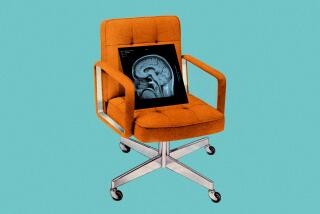Imaging helps diagnosis of severity of brain injuries
- Share via
In the last 20 years, it’s become more likely that a patient will survive an injury to the brain. But with better lifesaving techniques has come a pressing need to find out just how well the brain is functioning -- or if it is at all.
Several teams of doctors and scientists are now trying to do that. Using brain-imaging techniques and behavioral tests, they’re searching for more objective methods to determine a patient’s level of consciousness.
Doctors use a scale of brain responsiveness, says Mariano Sigman, director of the Integrative Neuroscience Laboratory at Buenos Aires University, where research into methods of testing conscious function are underway. “But it turns out not to be a great predictor of consciousness as measured by brain imaging.”
Proving this point was a study published online Feb. 3 in the New England Journal of Medicine. It found that five of 53 patients thought to be in a persistent vegetative state were actually able to demonstrate awareness -- and that one of those was found capable of communication.
Such research highlights both the limitations of doctors’ current assessments and the need to develop even more sophisticated tests. Just because a patient can demonstrate limited awareness doesn’t mean that he or she will be able to recover; conversely, patients who don’t respond to a specific test at a specific time may be able to improve.
Researchers’ current goal is to easily and definitively determine if an unresponsive patient is vegetative, minimally conscious or severely disabled. A “vegetative state” means the brain is functioning at only a basic level; the patient is awake (and sleeps) but isn’t aware of his or her surroundings. A “minimally conscious state” means a patient shows signs of conscious response, such as answering yes-or-no questions or responding to his or her name. One step up is “severely disabled,” in which a person shows spontaneous activity. (Such conditions are different from comas, in which the brain doesn’t respond to outside stimuli of any sort. A coma usually lasts days or weeks, but patients either recover some consciousness or die.)
But assessing state of consciousness is just the beginning. Researchers also want to better define such patients’ potential for recovery. With today’s imaging technology, that is increasingly possible.
Steven Laureys, head of the Coma Science Group at the University of Liege in Belgium, and a co-author on the New England Journal study, is trying to find out how well certain responses can predict recovery. He and fellow researchers found that patients who show higher-order responses on an fMRI (functional magnetic resonance imaging) scan -- after hearing their own name, for example -- are more likely to move up to a higher level of consciousness or be rehabilitated to some degree.
Other teams are working on similar methods to assess brain function. Dr. Damien Galanaud, at the department of neuroradiology at Pitié-Salpêtrière Hospital in Paris, has been exploring the potential of diffusive tensor imaging, an MRI technique that measures the movement of water in the brain. He notes that when the brain is damaged, the water no longer moves along the pathways that mark connections between damaged regions.
One of his studies, which involved 40 patients, suggested that four brain regions are connected with more negative outcomes. A bigger database, on which Galanaud is now working, will help show whether that connection is real. Given how little is known about the brain, he’s cautious. “Even now, a lot of the time we are just doing damage control” when a brain is injured, he said.
Meanwhile, Sigman and Tristan Bekinschtein, now at the Medical Research Council Cognition and Brain Sciences Unit in Cambridge, England, have invented a simple way to see if the brain is capable of learning. If so, the chance of recovery is greater. The test involves shooting a puff of air at the patient’s eye after playing a tone. If the patient eventually shows that he or she anticipates the puff -- by blinking after the tone, for instance -- then learning is obviously possible.
Such tests have shown promise in suggesting which patients are more likely to move to a more alert mental state. Of 23 patients, nine showed no ability to learn; 13 showed at least some ability. Of that latter group, 10 improved from a vegetative state to minimally conscious or from minimally conscious to severely disabled.
Sigman notes that his test is cheaper to do and simpler than an fMRI; it requires less training and is available to hospitals that don’t have the imaging machines. But the new brain scans are able to show where the damage is in a way that was once invisible.
Combined, the tests are a tool kit that was unavailable even a dozen years ago.
But the new studies may ultimately raise as many questions as they answer.
“If you don’t know whether someone is there, that doesn’t make it any better” for the families and caregivers, says Dr. Joseph J. Fins, chief of the division of medical ethics at Weill Cornell Medical College in New York. “Once you know, you have a moral responsibility to tend to their interests.”
Providing therapy is crucial to rehabilitating patients who show signs of responsiveness, Fins says. But some patients wouldn’t want such therapy if it had no hope of bringing them back to their pre-injured state.






